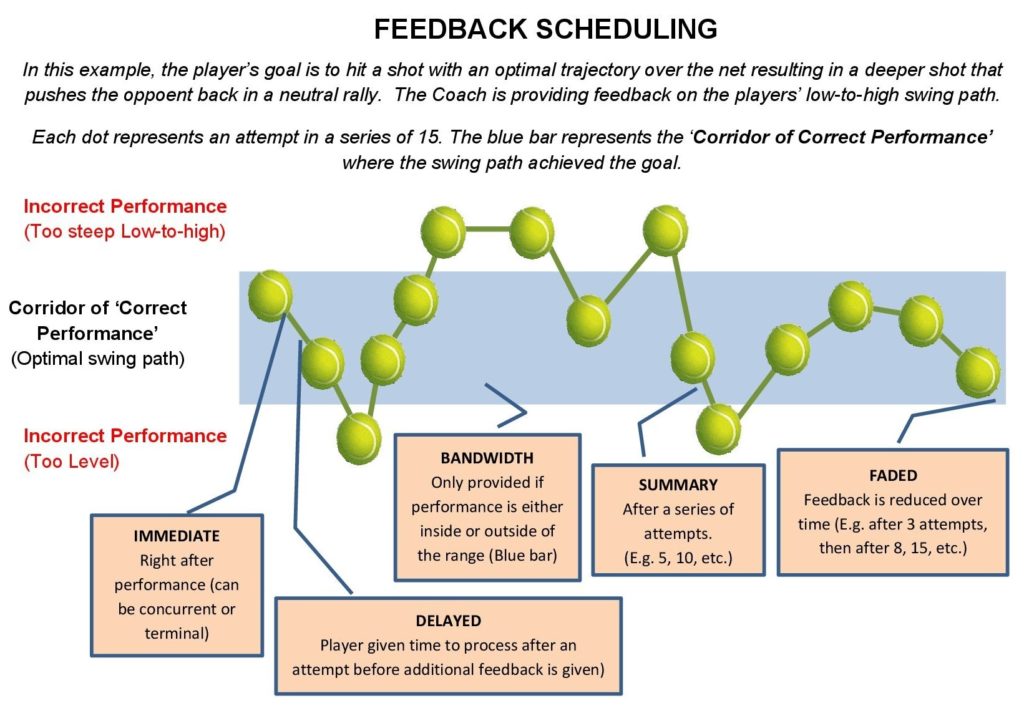
Coaches need to understand all the various types of feedback we have looked at in this series. However, to apply any of them, it is essential to determine when to use them. The timing of all the feedback types either enhances or detracts from their effectiveness as a learning tool.
DEFINITION OF FEEDBACK
Feedback in its simplest form reflects a player’s performance (and result) back to them’ (feeding-back). It ensures players have an accurate mirror to see their performance and its result for what it really is and how they can improve it. This is accomplished by directly communicating to them or setting up an environment where they gain feedback through other sources.
FEEDBACK WHEN?
Not all feedback is effective for enhancing learning. When feedback is received and how much plays an essential role in its effectiveness. There is terminology and definition for all the times and amount of feedback that can be received. There are two main categories of when feedback is received Feedback Timing and Feedback Scheduling.
Before we explore timing and scheduling, it is important to define two essential feedback elements called KP & KR:
KP: Knowledge of Performance
KP is about information received about the execution of the skill and can be gained through internal and external sources.
(Click here for article on Internal vs. External Feedback)
KR: Knowledge of Results
KR is about the result or effect of the performance. In tennis, we need always to be mindful that the performance of technique is always in service of a tactic.
In regards to KR, the effect of the execution has two levels:
- The first level that determines the effectiveness of the execution is what the ball did. The 5 Ball Control Characteristics describe this:
- Height
- Direction
- Distance
- Speed
- Spin
- Since tennis is a game requiring tactics against an opponent, the second level of effectiveness is about what the execution did to the opponent. All tactics in tennis have the goal of breaking an opponent’s timing as a result of the application of the Ball Control Characteristics:
- Challenge their ‘Lateral timing’ (make them stretch or ‘Jam’ them)
- Challenge their ‘Horizontal timing’ (make them impact too early or late)
- Challenge their ‘Vertical timing’ (make them impact above or below their comfort zone)
FEEDBACK TIMING
Feedback Timing is about when feedback is received in relation to the execution of the technical actions (KP) and the result and effect (KR). It is helpful to package both KP & KR together and call it a ‘shot’ (rather than a ‘stroke’). Therefore, in relation to the shot, timing of feedback is either:
- Concurrent
- Terminal
Concurrent Feedback:
This is feedback received while the skill execution is happening. It can be internal (the player proprioceptively feeling the swing path of their shot) or external (from the coach or environment). For example, when a coach says, ‘Swing more low to high?’ while the player is executing the shot is an example of concurrent external feedback.
- Advantage: Concurrent feedback is useful if the player is very unfamiliar with or doesn’t have a feel at all for the shot. It can help raise the player’s awareness of their performance or the effect.
- Disadvantage: Concurrent feedback given by a coach interferes with a player’s ability to solve problems and make decisions as the coach provides them with the answers.
Terminal Feedback:
This is feedback gained after the shot is completed. For example, if a player sees their ball go out, that is ‘Terminal’ feedback. Terminal Feedback is a form of ‘Outcome Feedback’ (in contrast to ‘Process Feedback’).
(Click here for additional article on Outcome vs. Process Feedback)
- Advantage: Terminal Feedback leads to superior results over Concurrent Feedback in terms of long-term retention and application of skills. In other words, it is better to wait to connect the feedback to the effect (which is the goal of all shots).
- Disadvantage: Terminal Feedback may leave a player confused if they are unable to connect their process to the outcome. E.g. I have a poor feel for the shot, and as a result, I ‘feel’ I am swinging low to high when, in reality, I am not.

FEEDBACK SCHEDULING
If Feedback Timing is about when the feedback is received regarding the shot, Feedback Scheduling is about the amount and frequency of the feedback received and includes:
- Immediate
- Delayed
- Summary
- Bandwidth
- Faded
NOTE: Let’s take a closer look at each one using a specific technical element. To better understand ‘when,’ we will use this example: Hitting a deeper shot that neutralizes an opponent by pushing them back (tactic) by having a low to high swing path on a crosscourt groundstroke (technique).
Immediate Feedback:
This is feedback received right after the shot. For example, after the shot, the coach says, ‘The swing was too level. See how the ball landed short?’
- Advantage: Immediate feedback gives the player information right away, allowing them to make instant changes.
- Disadvantage: The disadvantage of Immediate feedback is the same as Concurrent feedback. It interferes with a player’s ability to solve problems and make decisions as the coach provides all the solutions.
Delayed Feedback:
On the other end of the spectrum from Immediate feedback is to delay the feedback. Although the degree of delay is a topic of debate among researchers, we will say the delay can be ten seconds to a minute. The goal is to allow a player some processing time between attempts. The content of the feedback can be the same as Immediate feedback. Often, delayed feedback works well with questions that can spur reflection. For example, a coach could intervene after a shot and ask, ‘Did that shot push them back? What do you need to do more with your swing to keep her behind the baseline?’
(Click here for an article on using questions in coaching)
- Advantage: Delayed feedback gives space for players to work out their own solutions. It also allows the solutions to be stored in memory for later retrieval. This is a critical key for long-term shot improvement.
- Disadvantage: Delayed feedback is only a disadvantage if the player has no clue what the solution could be. The delay leaves them in a temporary lost state, which can adversely affect confidence.
Summary Feedback:
This is a form of delayed feedback focussing on the ‘trends’ of the shots rather than on specific attempts. A series of shots are observed, and a synopsis is provided. For example, after some attempts, the coach may say, ‘Most of your errors were long. What do you think that means about what you are mostly doing with your racquet path?’
- Advantage: Summary feedback helps prevent ‘information constipation. Shots suffer when a player is bombarded and overloaded with information. No one can think through multiple steps of an action and perform it smoothly. They need to feel it. Mistakes can happen by anyone (even Federer). If it was a ‘one-off’ mistake, additional feedback is irrelevant as it may not happen regularly. However, information about recurring errors (or successes) is helpful for improvement.
- Disadvantage: Summary feedback is only as good as the summary. Since the summary is a conclusion gained from several shots, there can be some subjectivity on what is important to summarize. For example, the coach may summarize that the player is ‘Not following-through,’ which is not relevant to the task since the follow-through does not directly determine the shot’s distance.
Bandwidth Feedback:
This feedback is only received if shots land outside (or inside) a pre-determined ‘corridor of correctness.’ This is a filter, so feedback is received when it is relevant. For example, the coach may choose to be a success-seeker rather than a fault-finder and reinforce with praise all the attempts with an optimal swing path.
- Advantage: Bandwidth feedback is a form of immediate feedback but only on attempts relevant to the success (or failure) of the shot.
- Disadvantage: Bandwidth feedback has all the disadvantages of immediate feedback. There is also a potential disadvantage if used as a tool to make errors the focus constantly. This may adversely affect a player’s confidence (since the coach only communicates with them when making a mistake).
Faded Feedback:
Faded feedback is simply feedback that is reduced over time. For example, it can be from a coach who diminishes the frequency or, for example, a player aiming for a target placed on the court and then the target is removed (thereby fading the feedback).
- Advantage: Faded feedback allows a coach to wean the player off their input to become more independent. It can be very individualized, and the coach can help the player learn at their own pace. Independence is the goal of tennis learning, as coaching isn’t even permitted in matches.
- Disadvantage: There are very few disadvantages for a coach to fade feedback unless they remove the feedback too quickly, leaving the player lost.

MULTIPLE CONNECTIONS – CHALLENGING APPLICATIONS
One of the reasons it is so difficult to master feedback is that so many of the elements are interconnected. For example, a player simply catching a poor service toss has received intrinsic, negative, implicit, kinesthetic & visual, immediate, terminal feedback. This allowed them to decide to catch the toss instead of hitting it. It is enough to make any coach’s head spin.
WHICH TIMING AND SCHEDULING DO YOU USE?
For the most part, the nature of tennis guides us to the feedback timing & scheduling that would be the most useful for tennis success. Tennis is a sport that requires high amounts of problem-solving and decision-making on every shot. Empowering players to be independent in these tasks is the objective of training.
The other critical objective of training is that truly learning something means players can retrieve solutions from long-term memory. When players receive constant and continuous feedback, they don’t have to remember anything. Practices with constant feedback are like a student ‘cramming’ for a test. They may pass the test tomorrow, but they will have no idea what the solutions were a week from now.
The types of feedback that achieve these objectives should be used more often (but not necessarily exclusively).
This is very counter-intuitive as most coaches (and parents) falsely believe a coach should comment every time a player makes a mistake (otherwise, they must be lazy or ignorant). Understanding the role of feedback helps eradicate these misconceptions.
The nature of tennis guides us into the type of feedback timing & scheduling that would be most useful for tennis success
CONCLUSION
By understanding the different timing and scheduling possible for feedback, a coach gains an entire toolbox of possibilities that allows them to construct an environment for the players that maximize learning effectiveness.
Leave a Reply